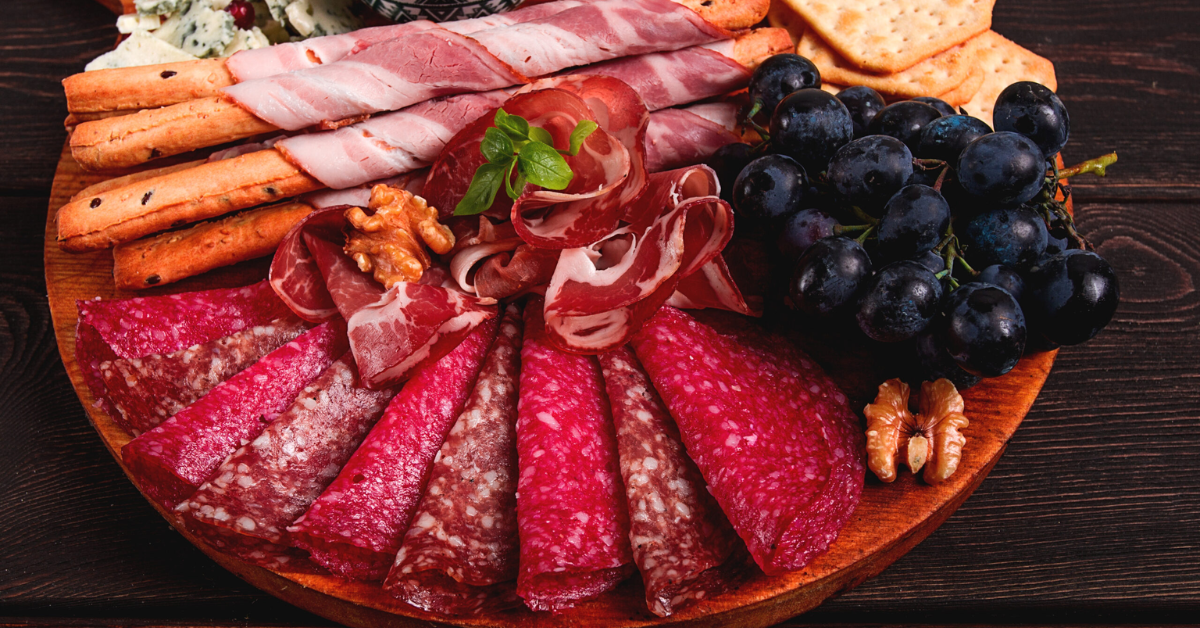Valentine’s Day is the season of love, and charcuterie boards are making a big splash this year. These delightful platters featuring an array of deli meats, cheeses, fruits, and crackers have become Instagram’s favorite Valentine’s Day trend.
Their aesthetic appeal and romantic presentation have made them the perfect snack for couples and even those enjoying the day solo. But before you dive into a heart-shaped meat rose, it’s important to understand the potential health risks associated with this trend.
Are Charcuterie Boards Healthy?
Charcuterie Boards Are Popular Not only Because of Their Visual Appeal but Also Because of The Variety They Offer. From tangy Cheeses to Crunchy Nuts and Crackers, These Boards Cater to Every Taste. But, at The Heart of Every Board Is the Star Ingredient – Deli Meats. These Pre-Cooked or Cured Meats Provide Protein, Which Helps Keep Hunger at Bay and Supports Muscle Maintenance. However, Experts Say that There’s a Downside to Enjoying These Meaty Delights.
Dr. Kirsten Bechtel, a Professor of Emergency Medicine at The Yale School of Medicine, Points out That Cured Meats Come with A heavy dose of Sodium. “Cured meats Are Treated with Salt, Nitrates, and Nitrites Before the Curing Process,” She Explains.
“While this Enhances Flavor and Helps Preserve the Meat, a Single Ounce Can Contain up To 600 Mg of Sodium.” For context, the Daily Recommended Limit for Sodium Intake Is 2,300 Mg for Healthy Adults. So, if You’re Enjoying More than A Few Ounces of Deli Meats, You May Easily Exceed This Amount.
Too Much Sodium in Your Diet Can Raise Blood Pressure and Increase the Risk of Heart Disease. The key, According to Experts, Is Moderation. You Can Still Enjoy Your Charcuterie Board, but Try Adding Ingredients Like Fresh Fruits, Vegetables, and Unsalted Nuts to Balance out Your Sodium Intake. This Not only Helps Cut Down on The Salty Content but Also Boosts the Fiber Content of Your Board, Keeping You Feeling Fuller for Longer.
The Risks of Deli Meats: Are Charcuterie Boards Safe to Eat?
While Charcuterie Boards Are Certainly Delicious, They Come with Some Inherent Health Risks, Particularly when It Comes to Deli Meats. One of The Biggest Concerns Is the Potential for Foodborne Illnesses Like Listeria. Jamie Pronschinske, a Registered Dietitian at The Mayo Clinic Health System, Explains that Deli Meats, Such as Cold Cuts and Sausages, Can Sometimes Harbor Harmful Bacteria Like Listeria.
Listeria Is a Bacteria that Can Thrive in Environments Where Food Is Stored Improperly. While Cooking or Drying Meat Typically Kills Bacteria, Contamination Can Occur After the Meat Has Been Prepared and Before It Is Served. The Risk Is Heightened if The Meats Are Left out At Room Temperature for Too Long. Refrigeration Doesn’t Kill Listeria, and If You Want to Avoid Contamination, You Should Reheat Deli Meats to 165°f Before Eating Them.

In 2022, the Centers for Disease Control and Prevention (CDC) Reported a Listeria Outbreak Tied to Deli Meats, Resulting in One Death and Several Hospitalizations. The outbreak Also Led to A Miscarriage in A Pregnant Woman, Which Is Why Doctors Advise Pregnant Women to Avoid Deli meat due to The Increased Risk of Foodborne Illnesses that Could Harm the Fetus.
Pregnant Women, Young Children, Older Adults, and Those with Weakened Immune Systems Are Particularly Vulnerable to Foodborne Illnesses. Dr. Bechtel Recommends that These Groups Avoid Charcuterie Boards to Reduce the Risk of Contamination, Which Can Occur Even with Common Items Like Unpasteurized Cheeses, Which Often Accompany Deli Meats on These Platters.
Salmonella: Another Reason to Be Cautious
The Risks Don’t End with Listeria. In addition to The Bacterial Threats from Improper Storage and Handling, There’s Also the Risk of Salmonella, Which Is Another Common Cause of Food Poisoning.
Earlier This Year, Over 11,000 Pounds of Charcuterie Meats Were Recalled Across Several States After Salmonella Contamination Was Detected. Salmonella Outbreaks Linked to Charcuterie Meats Have Been Reported Before, Including One in 2021 that Sickened Dozens of People.
How to Enjoy Charcuterie Safely
Given These Risks, You May Wonder if It’s Safe to Enjoy a Charcuterie Board at All. Fortunately, There Are Steps You Can Take to Enjoy Your Platter without Compromising Your Health.
The First Rule Is to Ensure Your Meats, Cheeses, and Produce Are Kept at The Correct Temperature. Dr. Bechtel Recommends Keeping the Board Refrigerated for At Least Two Hours Before Serving to Prevent the “danger Zone” from Being Breached.
This Is the Temperature Range Above 40°f, Where Harmful Bacteria Can Multiply Rapidly. If the Charcuterie Board Has Been Out For More than Two Hours, It’s Best to Replace the Items, Especially if The Air Temperature Exceeds 90°f, Which Can Cause the Food Temperature to Rise Even Faster.
It’s Also Important to Keep Everything Clean. If you’re Enjoying a Charcuterie Board Where the Meats Are Shaped Into Decorative Pieces, Make Sure the Person Crafting the Board Washes Their Hands Properly. Foodborne Illnesses Often Arise from Cross-Contamination, Which Is Why Hygiene Is Key.
Conclusion
There’s No Reason to Avoid Charcuterie Boards This Valentine’s Day. These Boards Offer a Fun, Festive Way to Indulge in A Variety of Delicious Treats, but They Do Come with Some Health Considerations. By being Mindful of Sodium Intake, Ensuring Proper Food Handling, and Following the Health Tips Provided, You Can Safely Enjoy Your Board While Keeping Your Health in Check.
If You Love Charcuterie but Want to Stay on The Safe Side, Adding Fresh Fruits, Vegetables, and Unsalted Nuts to Your Platter Is a Smart Move. Enjoy Your Romantic Day with Delicious Snacks, but Always Prioritize Safety and Health — Because Nothing Ruins a Holiday Faster than Food Poisoning!
Note: Every piece of content is rigorously reviewed by our team of experienced writers and editors to ensure Accuracy. Our Writers Use Credible Sources and Adhere to Strict Fact-Checking Protocols to Verify All Claims and Data Before Publication. If an Error Is Identified, We Promptly Correct It and Strive for Transparency in All Updates.







Leave a Comment